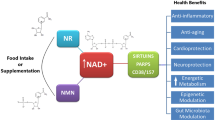Abstract
The antilipolytic activity of homocysteine-thiolactone-nicotinamide (ST22) and its 2-chloro (ST71), 6-chloro (ST82) and 6-hydroxy (ST90) derivatives was investigated by evaluation of serum free fatty acids (FFA) and triglycerides (TG) (in vivo) and FFA release from adipose tissue (in vitro). Increased FFA levels in 17-hr fasted rats at 60 min following treatment with 7·10−4 mol kg−1 p.o. were reduced by 70% (ST22), 60% (ST82) and 18% (ST71), whereas ST90 provoked no change; TG levels showed similar changes. Basal FFA release from epididymal rat adipose tissue at 60 min following treatment with 7·10−4 mol kg−1 p.o. of ST22 and ST82 was reduced by 79 and 45%, respectively. Lipid mobilization induced by noradrenaline (NA) was diversely affected by the compounds according to the tests employed: with in vivo experiments, serum FFA levels were reduced by 60, 70, 10 and 5% at 60 min following treatment with ST22, ST82, ST71 and ST90, respectively (7·10−4 mol kg−1 p.o.; NA bitartrate, 2 mg kg−1 s.c.); in vitro, ST22 produced no change, whereas the other compounds induced a significant mobilization of FFA. The results suggest that: (a) antilipolytic activity can be greatly modified when various substituents capable of influencing either the inductive (-I) or the resonance (+M) effect are introduced into the different positions of the pyridine ring; and (b) the lipolysis experiments did not evince any direct relationship between the effects obtained by the in vivo tests and those obtained by the in vitro tests.
Similar content being viewed by others
References
Ramacci, M.T., Maccari, F., and Ghirardi, O., G.I.R.F.-S.I.S.F. Symposium, Rome, Oct. 2–4, 1975.
Gerritsen, G.C., and Dulin, W.E. (1965) Diabetes 14, 507–515.
Gerritsen, G.C., and Dulin, W.E. (1965) J. Pharmacol. Exp. Ther. 150, 491–498.
Gerritsen, G.C., Dulin, W.E., and Kupiecki, F. P. (1969) in Drugs Affecting Lipid Metabolism Holmes, W.L., Carlson, L.A., and Paoletti, R., (eds.) pp. 93–103, Plenum Press, New York, NY.
Smith, D.L., Forist, A.A., and Dulin, W.E. (1965) J. Med. Chem. 8, 350–353.
Bizzi, A., Codegoni, A.M., and Garattini, S. (1967) Il Farmaco, Ed. Sci. 22, 709–716.
Bizzi, A., Codegoni, A.M., and Garrattini, S. (1969) Biochem. Pharmacol. 18, 2053–2060.
Van Handel, E., and Zilversmith, D.B. (1957) J. Lab. Clin. Med. 50, 152–157.
Dole, V.P. (1956) J. Clin. Invest. 35, 150–154.
Trout, D.L., Estes, E.H., and Friedberg, S.J. (1960) J. Lipid Res. 1, 199–202.
Author information
Authors and Affiliations
About this article
Cite this article
Maccari, F., Ghirardi, O., De Witt, P. et al. In vivo and in vitro antilipolytic effects of some various substituted homocysteine-thiolactone-nicotinamides: Structure-activity study. Lipids 17, 78–83 (1982). https://doi.org/10.1007/BF02535179
Received:
Issue Date:
DOI: https://doi.org/10.1007/BF02535179




